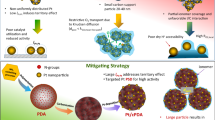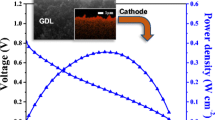Abstract
Device testing of polymer electrolyte membrane fuel cell catalysts is essential for electrocatalyst development, yet most reported catalysts fabricated with nanoceramic coatings via atomic layer deposition (ALD) have not been thoroughly examined in this fashion. Platinum nanoparticle catalysts supported on functionalized XC72 carbon black that had been modified with sub-monolayer WN films and subjected to various thermal treatments were incorporated into membrane electrode assemblies and tested for oxygen reduction reaction activity in a fuel cell. The mass activities of the catalysts calculated at low current densities had comparable trends to those previously recorded in aqueous half-cell testing; however, significant deviations in catalyst performance became apparent at high current densities in the mass transport region of the polarization curves. The poor performance of the ALD-modified catalysts was attributed to water flooding induced by the low hydrophobicity of these catalyst layers, as determined by contact angle measurements on the cathode surfaces. It was seen that hydrophobicity was increased by thermal treatment and removal of surface groups known to be prone to hydrogen bonding, thereby improving the catalyst performance in the mass transport region. A heat-treated WN-coated ALD catalyst was found to have superior performance to commercial Pt/C. The field of research on fuel cell catalyst design via ALD is rapidly expanding, and this work demonstrates the importance of understanding the impact of ALD-deposited nanostructures on materials properties beyond the pure electrocatalytic activity.




Similar content being viewed by others
Data availability
Data available upon request.
References
Antolini E, Gonzalez ER (2010) Tungsten-based materials for fuel cell applications. Appl Catal B Environ 96(3–4):245–266
Avcioglu GS, Ficicilar B, Eroglu I (2018) Improved PEM fuel cell performance with hydrophobic catalyst layers. Int J Hydrog Energy 43(40):18632–18641
Azimi G, Dhiman R, Kwon HM, Paxson AT, Varanasi KK (2013) Hydrophobicity of rare-earth oxide ceramics. Nat Mater 12(4):315–320
Barton SS, Evans MJB, Halliop E, MacDonald JAF (1997) Acidic and basic sites on the surface of porous carbon. Carbon 35(9):1361–1366
Becker JS, Gordon RG (2003) Diffusion barrier properties of tungsten nitride films grown by atomic layer deposition from bis(tert-butylimido)bis(dimethylamido)tungsten and ammonia. Appl Phys Lett 82(14):2239–2241
Biniak S, Szymanski G, Siedlewski J, Swiatkowski A (1997) The characterization of activated carbons with oxygen and nitrogen surface groups. Carbon 35(2):1799–1810
Cao M, Wu D, Cao R (2014) Recent advances in the stabilization of platinum Electrocatalysts for fuel-cell reactions. Chem Cat Chem 6(1):26–45
Cheng N, Banis MN, Liu J, Riese A, Li X, Li R, Ye S, Knights S, Sun X (2015) Extremely stable platinum nanoparticles encapsulated in a zirconia nanocage by area-selective atomic layer deposition for the oxygen reduction reaction. Adv Mater 27(2):277–281
Cheng N, Shao Y, Liu J, Sun X (2016) Electrocatalysts by atomic layer deposition for fuel cell applications. Nano Energy 29:220–242
Folgado MA, Conde JJ, Ferreira-Aparicio P, Chaparro AM (2018) Single cell study of water transport in PEMFCs with Electrosprayed catalyst layers. Fuel Cells 18(5):602–612
Graeser KA, Patterson JE, Zeitler JA, Rades T (2010) The role of configurational entropy in amorphous systems. Pharmaceutics 2(2):224–244
Ham D, Lee J (2009) Transition metal carbides and nitrides as electrode materials for low temperature fuel cells. Energies 2(4):873–899
Lee WJ, Bera S, Shin HC, Hong WP, Oh SJ, Wan Z, Kwon SH (2019) Uniform and size-controlled synthesis of Pt nanoparticle catalyst by fluidized bed reactor atomic layer deposition for PEMFCs. Adv Mater Interfaces 6(21):1901210
Li H, Tang Y, Wang Z, Shi Z, Wu S, Song D, Zhang J, Fatih K, Zhang J, Wang H, Liu Z, Abouatallah R, Mazza A (2008) A review of water flooding issues in the proton exchange membrane fuel cell. J Power Sources 178(1):103–117
Lubers AM, Muhich CL, Anderson KM, Weimer AW (2015) Mechanistic studies for depositing highly dispersed Pt nanoparticles on carbon by use of trimethyl(methylcyclopentadienyl)platinum(IV) reactions with O2 and H2. J Nanopart Res 17(4):179
Lubers AM, Drake AW, Ludlow DJ, Weimer AW (2016) Electrochemical hydrogen pumping using a platinum catalyst made in a fluidized bed via atomic layer deposition. Powder Technol 296:72–78
Lubers AM, McNeary WW, Ludlow DJ, Drake AW, Faust M, Maguire ME, Kodas MU, Seipenbusch M, Weimer AW (2017) Proton exchange membrane fuel cell flooding caused by residual functional groups after platinum atomic layer deposition. Electrochim Acta 237:192–198
Marichy C, Ercolano G, Caputo G, Willinger MG, Jones D, Rozière J, Pinna N, Cavaliere S (2016) ALD SnO2 protective decoration enhances the durability of a Pt based electrocatalyst. J Mater Chem A 4(3):969–975
Mauger SA, Neyerlin KC, Alia SM, Ngo C, Babu SK, Hurst KE, Pylypenko S, Litster S, Pivovar BS (2018) Fuel cell performance implications of membrane electrode assembly fabrication with platinum-nickel nanowire catalysts. J Electrochem Soc 165(3):F238–F245
McNeary WW, Linico AE, Ngo C, van Rooij S, Haussener S, Maguire ME, Pylypenko S, Weimer AW (2018) Atomic layer deposition of TiO2 for stabilization of Pt nanoparticle oxygen reduction reaction catalysts. J Appl Electrochem 48(9):973–984
McNeary WW, Zaccarine SF, Lai A, Linico AE, Pylypenko S, Weimer AW (2019) Improved durability and activity of Pt/C catalysts through atomic layer deposition of tungsten nitride and subsequent thermal treatment. Appl Catal B Environ 254:587–593
Musil J, Zenkin S, Kos Š, Čerstvý R, Haviar S (2016) Flexible hydrophobic ZrN nitride films. Vacuum 131:34–38
Oh I-K, Kim K, Lee Z, Ko KY, Lee C-W, Lee SJ, Myung JM, Lansalot-Matras C, Noh W, Dussarrat C, Kim H, Lee H-B-R (2015) Hydrophobicity of rare earth oxides grown by atomic layer deposition. Chem Mater 27(1):148–156
Sankar S, Nair BN, Suzuki T, Anilkumar GM, Padmanabhan M, Hareesh UN, Warrier KG (2016) Hydrophobic and metallophobic surfaces: highly stable non-wetting inorganic surfaces based on lanthanum phosphate nanorods. Sci Rep 6:22732
Srinivasan, S. (2006). Fuel cell principles. Fuel cells: from fundamentals to applications. Boston, MA, springer: 189-233
Weimer AW (2019) Particle atomic layer deposition. J Nanopart Res 21(1):9
Weng Z, Zaera F (2019) Atomic layer deposition (ALD) as a way to prepare new mixed-oxide catalyst supports: the case of alumina addition to silica-supported platinum for the selective hydrogenation of cinnamaldehyde. Top Catal 62(12–16):838–848
Zenkin S, Kos Š, Musil J, Rohrer G (2014) Hydrophobicity of thin films of compounds of low-electronegativity metals. J Am Ceram Soc 97(9):2713–2717
Acknowledgments
The authors would like to thank Jeremiah Traeger for assistance with contact angle measurements.
Funding
WM received financial support from the U.S. Department of Education Graduate Assistance in Areas of National Need Program (Award P200A120125) and National Science Foundation Graduate Research Fellowship (DGE 1144083).
Author information
Authors and Affiliations
Corresponding author
Ethics declarations
Conflict of interest
A.W. Weimer has a significant financial interest in Forge Nano.
Additional information
Publisher’s note
Springer Nature remains neutral with regard to jurisdictional claims in published maps and institutional affiliations.
Electronic supplementary material
ESM 1
(DOCX 2978 kb)
Rights and permissions
About this article
Cite this article
McNeary, W.W., Linico, A.E. & Weimer, A.W. Water management implications for ALD-modified polymer electrolyte membrane fuel cell catalysts. J Nanopart Res 22, 185 (2020). https://doi.org/10.1007/s11051-020-04921-8
Received:
Accepted:
Published:
DOI: https://doi.org/10.1007/s11051-020-04921-8




